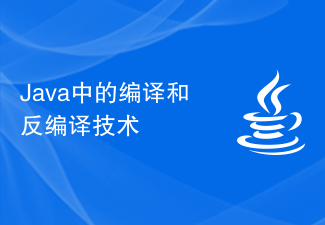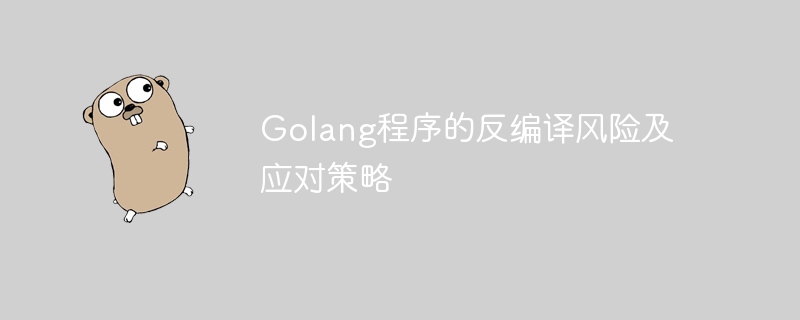Golang cannot be decompiled. Reason: Golang is a compiled static language. Golang will generate binary files after compilation, and binary files are files containing data or program instructions written in ASCII and extended ASCII characters. These files contain special formats and computer codes, so Cannot be decompiled.

The operating environment of this tutorial: Windows 7 system, GO version 1.18, Dell G3 computer.
Golang does not support decompilation.
Reason:
Go language is a compiled static language, so before running a Go language program, it must be compiled into a binary executable document.
Golang will generate binary files after compilation, and binary files are files containing data or program instructions written in ASCII and extended ASCII characters. These files contain special formats and computer codes, so they cannot be decompiled.
Benefits of binary files
Why use binary files. There are probably three reasons:
The first is that binary files save space, and there is no difference between the two when storing character data. However, when storing numbers, especially real numbers, binary is more space-saving. For example, storing Real*4 data: 3.1415927, a text file requires 9 bytes, and respectively stores: 3. 1 4 1 5 9 2 7 these 9 ASCII value, while binary files only require 4 bytes (DB 0F 49 40)
The second reason is that the data involved in calculations in the memory are stored in binary unformatted format, so using binary Saving to a file is faster. If stored as a text file, a conversion process is required. When the amount of data is large, there will be a significant speed difference between the two.
Third, for some relatively precise data, using binary storage will not cause the loss of valid bits.
How to store binary files
List a binary file as follows:
00000000h:0F 01 00 00 0F 03 00 00 12 53 21 45 58 62 35 34; .........S!EXb54 00000010h:41 42 43 44 45 46 47 48 49 47 4B 4C 4D 4E 4F 50; ABCDEFGHIGKLMNOP
The ones listed here are what you see in UltraEdit (UE) thing. In fact, only the red part is the file content. The preceding one is the line number added by UE. What follows is a reference that UE attempts to interpret as a character.
This file is 32 bytes long. Displayed as two columns of 16 bytes each. In fact, this is just a display of UE. Real files don't have separate lines. Just knowing the contents of this file, if we don't have any explanation, we can't see any useful information.
I will stipulate an explanation below: We believe that the first 4 bytes are a 4-byte integer data (0F 01 00 00 hexadecimal: 10Fh decimal: 271). The 4 bytes after these 4 bytes are another 4 bytes of integer data (0F 03 00 00 hexadecimal: 30Fh decimal: 783). The following 4 bytes (12 53 21 45) represent a 4-byte real data: 2.5811919E 3. The following 4 bytes (58 62 35 34) represent another 4 bytes of execution data: 1.6892716E-7. And only the last 16 bytes (41 42 43 44 45 46 47 48 49 47 4B 4C 4D 4E 4F 50) we think are 16 bytes of string (ABCDEFGHIGKLMNOP)
Actually, the binary file It just stores data without specifying the data type. For example, the 9th byte to the 16th byte above (12 53 21 45 58 62 35 34), we just thought it was two 4-byte real types, but it can actually be Considered to be an 8-byte character type (S!EXb54). The following 16-byte string (ABCDEFGHIGKLMNOP) can also be considered as two 8-byte integers, or four 4-byte integers, or even two 8-byte real types, and four 4-byte real type, etc. etc.
Therefore, when facing a binary file, we cannot accurately know its meaning. We need a description of its data storage method. This description tells us what type of data is from which byte to which byte, and what is the meaning of the stored data. Otherwise, we can only guess or be helpless.
【Related recommendations: Go video tutorial, Programming teaching】
The above is the detailed content of Can golang be decompiled?. For more information, please follow other related articles on the PHP Chinese website!
 go语言有没有缩进Dec 01, 2022 pm 06:54 PM
go语言有没有缩进Dec 01, 2022 pm 06:54 PMgo语言有缩进。在go语言中,缩进直接使用gofmt工具格式化即可(gofmt使用tab进行缩进);gofmt工具会以标准样式的缩进和垂直对齐方式对源代码进行格式化,甚至必要情况下注释也会重新格式化。
 Golang代码反编译的挑战与解决方案Apr 03, 2024 am 11:18 AM
Golang代码反编译的挑战与解决方案Apr 03, 2024 am 11:18 AMGo代码反编译的挑战在于其编译后的本质和类型化。要解决这些问题,有以下解决方案:Ghidra:基于不可知解译器的开源框架。GoUnpack:专门的反编译工具,可恢复类型信息和函数签名。DeLab:商业软件,提供GUI来可视化和分析代码。
 Java 中的编译和反编译技术Jun 09, 2023 am 09:43 AM
Java 中的编译和反编译技术Jun 09, 2023 am 09:43 AMJava是一种非常流行的编程语言,广泛应用于开发各种类型的软件。在Java开发中,编译和反编译技术是非常重要的环节。编译技术用于将Java代码转换成可执行文件,而反编译技术则允许人们将可执行文件重新转换回Java代码。本文将介绍Java中的编译和反编译技术。一、编译技术编译是将高级语言(如Java)代码转换为机器语言的过程。在Java
 go语言为什么叫goNov 28, 2022 pm 06:19 PM
go语言为什么叫goNov 28, 2022 pm 06:19 PMgo语言叫go的原因:想表达这门语言的运行速度、开发速度、学习速度(develop)都像gopher一样快。gopher是一种生活在加拿大的小动物,go的吉祥物就是这个小动物,它的中文名叫做囊地鼠,它们最大的特点就是挖洞速度特别快,当然可能不止是挖洞啦。
 Java反编译工具的技巧:从初学者到专家的进阶指南Jan 09, 2024 pm 07:37 PM
Java反编译工具的技巧:从初学者到专家的进阶指南Jan 09, 2024 pm 07:37 PM从入门到精通:掌握Java反编译工具的技巧导语:在软件开发领域,Java语言已经成为了最为流行和广泛使用的语言之一。而在编写和调试Java代码时,有时候我们需要对已经编译的代码进行反编译以获取更多信息。因此,掌握常用的Java反编译工具和技巧,对于Java开发者来说是非常重要的。一、Java反编译工具的介绍Java反编译工具是一种将已编
 Golang程序的反编译风险及应对策略Apr 03, 2024 am 10:09 AM
Golang程序的反编译风险及应对策略Apr 03, 2024 am 10:09 AMGolang程序的反编译风险及应对策略反编译是指将已编译的二进制可执行文件转换为源代码的过程。对于Golang程序,反编译可以揭示实际实现,从而带来安全隐患。反编译风险源代码泄露:反编译后的源代码包含应用程序的全部逻辑和实现细节,泄露后可能会被恶意利用。算法窃取:对于机密算法或技术来说,反编译会暴露其核心原理,从而使竞争对手受益。恶意代码注入:反编译后的代码可以被修改并重新编译,其中可能包含恶意代码,给应用程序带来后门或安全漏洞。应对策略应用层模糊处理:使用模糊处理技术混淆代码,使得反编译后的源


Hot AI Tools

Undresser.AI Undress
AI-powered app for creating realistic nude photos

AI Clothes Remover
Online AI tool for removing clothes from photos.

Undress AI Tool
Undress images for free

Clothoff.io
AI clothes remover

AI Hentai Generator
Generate AI Hentai for free.

Hot Article

Hot Tools

Dreamweaver CS6
Visual web development tools

Zend Studio 13.0.1
Powerful PHP integrated development environment

Safe Exam Browser
Safe Exam Browser is a secure browser environment for taking online exams securely. This software turns any computer into a secure workstation. It controls access to any utility and prevents students from using unauthorized resources.

SublimeText3 Mac version
God-level code editing software (SublimeText3)

Atom editor mac version download
The most popular open source editor








